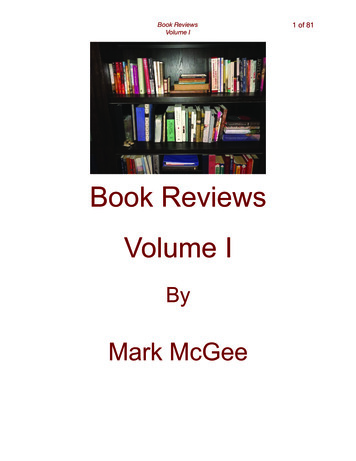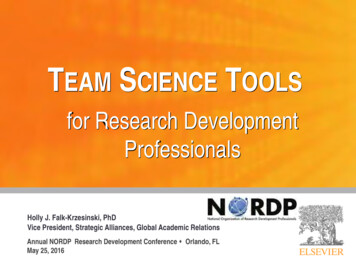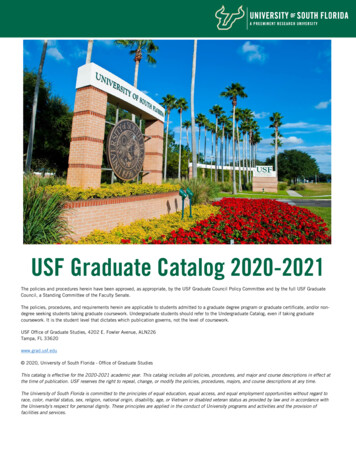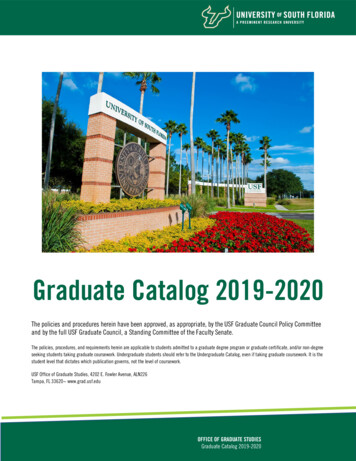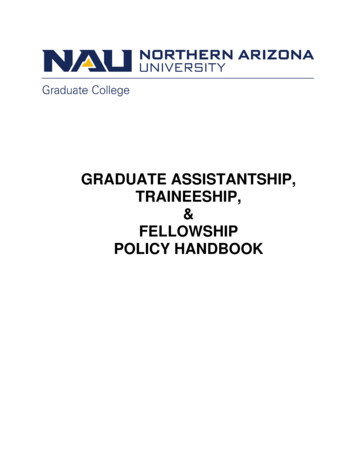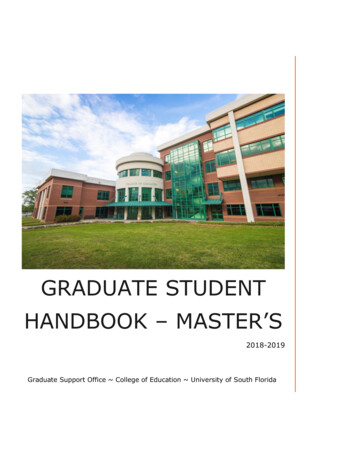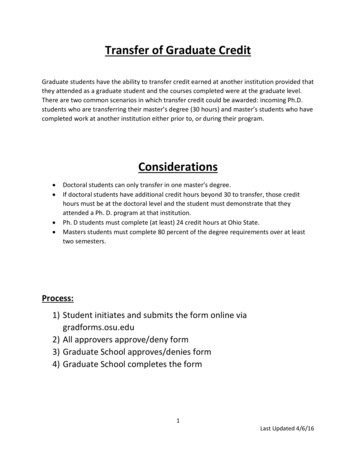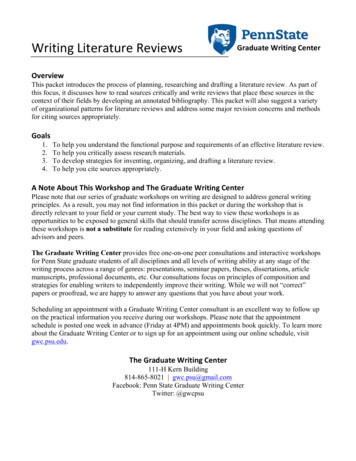
Transcription
Writing Literature ReviewsGraduate Writing CenterOverviewThis packet introduces the process of planning, researching and drafting a literature review. As part ofthis focus, it discusses how to read sources critically and write reviews that place these sources in thecontext of their fields by developing an annotated bibliography. This packet will also suggest a varietyof organizational patterns for literature reviews and address some major revision concerns and methodsfor citing sources appropriately.Goals1.2.3.4.To help you understand the functional purpose and requirements of an effective literature review.To help you critically assess research materials.To develop strategies for inventing, organizing, and drafting a literature review.To help you cite sources appropriately.A Note About This Workshop and The Graduate Writing CenterPlease note that our series of graduate workshops on writing are designed to address general writingprinciples. As a result, you may not find information in this packet or during the workshop that isdirectly relevant to your field or your current study. The best way to view these workshops is asopportunities to be exposed to general skills that should transfer across disciplines. That means attendingthese workshops is not a substitute for reading extensively in your field and asking questions ofadvisors and peers.The Graduate Writing Center provides free one-on-one peer consultations and interactive workshopsfor Penn State graduate students of all disciplines and all levels of writing ability at any stage of thewriting process across a range of genres: presentations, seminar papers, theses, dissertations, articlemanuscripts, professional documents, etc. Our consultations focus on principles of composition andstrategies for enabling writers to independently improve their writing. While we will not “correct”papers or proofread, we are happy to answer any questions that you have about your work.Scheduling an appointment with a Graduate Writing Center consultant is an excellent way to follow upon the practical information you receive during our workshops. Please note that the appointmentschedule is posted one week in advance (Friday at 4PM) and appointments book quickly. To learn moreabout the Graduate Writing Center or to sign up for an appointment using our online schedule, visitgwc.psu.edu.The Graduate Writing Center111-H Kern Building814-865-8021 gwc.psu@gmail.comFacebook: Penn State Graduate Writing CenterTwitter: @gwcpsu
Page 2 of 16What is a Literature Review?A literature review is a critical look at the existing research that is significant to the work that you arecarrying out. Think of the topic in terms of a conversation.Although literature reviews share distinctive features across disciplines, your approach to them willchange depending upon where you are in the writing process, upon who your audience is, and uponwhether you are writing one as a standalone essay or as introductory matter for a larger article.Purposes of a Literature Review Provides background information on the topic in the scholarly conversation Establishes importance of topic to the scholarly conversation Demonstrates your familiarity with the scholarly conversation “Carves out a space” for further work and allows you to position yourself in the scholarlyconversationCharacteristics of an Effective Literature ReviewIn addition to fulfilling the purposes outlined above, an effective review offers a functional overview ofexisting research by: Outlining important research trends in the conversation Assessing the strengths and weaknesses of existing research Identifying potential gaps in knowledge Establishing a need for current and/or future research projectsSteps (or Strategies) of the Literature Review Process1. Planning: identify the focus, type, scope and discipline of the review you intend to write.2. Reading and Research: collect and read current research on your topic. Select only thosesources that are most relevant to your project.3. Analyzing: summarize, synthesize, critique, and compare your sources in order to assess thefield of research as a whole.4. Finding the Big Picture: consider the overall picture that emerges.5. Organizing: structure the information.6. Drafting: develop a thesis or claim to make about the existing research and decide how toorganize your material.7. Revising: revise and finalize the paper’s structural, stylistic, and grammatical issues.This process is not always linear. Depending on the size and scope of your literature review, you mayfind yourself returning to some of these steps repeatedly as you develop your project.STEP 1: Planning: What Kind of Literature Review Am I Writing?As you plan to write your review, you’ll need to begin by asking: What kind of review am Iwriting? What are the focus, type, scope, and discipline of my review? Focus: What is the specific thesis, problem, or research question that my literature review isresponding to or defining? Type: What type of review am I conducting? Will my review emphasize theory, methodology,policy, or qualitative or quantitative studies?2
Page 3 of 16 Scope: What is the scope of material I will include in terms of date, discipline, forms, etc.? Whattype of sources will I be using? Discipline: What academic discipline(s) will be included (e.g. Nursing, Psychology, Sociology,Medicine)? Remember interdisciplinary work has to account for field differences in acceptablecourses of research.EXERCISE: Planning a Literature Review1. What is the specific thesis, problem, or research question that my literature review is defining orresponding to?2. What type of literature review am I conducting (theory; methodology; policy; quantitative;qualitative)?3. What is the scope of my literature review (date, discipline, forms, etc)? What types of sourcesam I using?4. What field(s) am I working in? (Remember, interdisciplinary work has to account for fielddifferences in acceptable sources of research.)STEP 2: Reading and Research: What Material Will I Use?Collecting and reading current research on your topic may entail several steps:1. Collect and Read Material: Collect literature relevant to your topic that fits within the focus,type, and discipline you have chosen for your review. Use databases, bibliographies, andrecommendations from advisors to identify source material. Read the sources carefully enough tounderstand their main arguments and relevance to your study.2. Summarize: Once you have read your source material, consider writing a brief summary of thetext that answers the following questions:a. Who is the author?b. What is the author's main purpose?c. What is the author’s theoretical perspective? Research methodology?d. Who is the intended audience?e. What is the principal point, conclusion, thesis, contention, or question?3
Page 4 of 16f.g.h.i.How is the author’s position supported (or not)?How does this study relate to other studies of the problem or topic?What does this study add to your project?What are the strengths and weaknesses of the author’s work? Will your work address anyof the weaknesses identified?3. Organize an Annotated Bibliography: List the readings in short paragraphs based on thequestions in 2 with correct citations, e.g.,Barthelemy, J., & Geyer, D. (2005). An empirical investigation of IT outsourcing versus outsourcing inFrance and Germany. Information & Management, 42, 533-542. doi:10.1016/j.im.2004.02.005The authors present an investigation of IT outsourcing based on the combined results of a surveyadministered to IT firms as well as statistical measures from domestic and French or Germanfirms. Their data covers a wide range of IT business unit types. However, the lack of longitudinaldata weakens their conclusion that the slower pace of French and German IT outsourcing has hada positive effect on business in those countries long-term.**Please note: These annotated bibliography summaries will not get incorporated into your finalliterature review. Their purpose is to help you clarify your understanding of what each text isarguing and what approach(es) the author(s) uses.**4. Select: Your next step is to sort through your summaries and select only those books and articlesthat are most relevant to your project. Resist the temptation to incorporate everything you haveread – this will make the task harder.STEP 3: Analyzing: How Can I Assess Existing Research?A literature review is never just a list of studies—it always offers an argument about a body of research.In other words, an annotated bibliography is not a lit review. Your lit review needs to balance summaryand analysis. This analysis occurs on two levels: individual studies and the field as a whole. These fourtasks—common analytical patterns—will help you analyze the existing research in your field:Tasks reSummary and SynthesisIn your own words, summarize and/or synthesize the key findings relevant to your study. Consider thefollowing questions about the field as a whole: What do we know about the immediate area? What are the key arguments, key characteristics, key concepts or key figures? What are the existing debates/theories? What common methodologies are used?4
Page 5 of 16Sample Language for Summary and Synthesis: Normadin has demonstrated Early work by Hausman, Schwarz, and Graves was concerned with Elsayed and Stern compared algorithms for handling Additional work by Karasawa et. al, Azadivar, and Parry et. al deals with Example of Summary and Synthesis:Under the restriction of small populations, four possible ways [to avoid premature convergence] were presented.The first one is to revise the gene operators . Griffiths and Miles applied advanced two-dimensional geneoperators to search the optimal cross-section of a beam and significantly improve results. The second way is toadjust gene probability. Leite and Topping adopted a variable mutation probability and obtained an outperformedresult Comparison and CritiqueCompare and critique articles to establish the strengths and weakness of your field of research. Note thatyou may not recognize strengths and weaknesses until you have read widely in your subject and begin tosee which studies are stronger. As you compare studies, you’ll begin to be able to offer critique.Consider the following questions: How do the different studies relate? What is new, different, or controversial? What views need further testing? What evidence is lacking, inconclusive, contradicting, or too limited? What research designs or methods seem unsatisfactory?Sample Language for Comparison and Critique: In this ambitious but flawed study, Jones and Wang These general results, reflecting the stochastic nature of the flow of goods, are similar to thosereported by Rosenblatt and Roll Examples of Comparison and Critique:The critical response to the poetry of Phillis Wheatley often registers disappointment or surprise. Some criticshave complained that the verse of this African American slave is insecure (Collins 1975, 78), imitative(Richmond 1974, 54-66), and incapacitated (Burke 1991, 33, 38)—at worst, the product of a “White mind”(Jameson 1974, 414-15). Others, in contrast, have applauded Wheatley’s critique of Anglo-American discourse(Kendrick 1993, 222-23), her revision of literary models The situationist model has also received its share of criticism. One of the most frequently cited shortcomings ofthis approach centers on the assumption that individuals enter into the work context tabula rasa.Analyzing through Language: Evaluative Adjectives and VerbsIn order to effectively articulate your critique or synopsis, you will want to use evaluative adjectives andreporting verbs. Remember that a critique can be positive, neutral (functional) or negative; what thereader wants from you is your assessment of the available literature or scholarly conversation on thetopic.Evaluative orycompleximpressive5
Page 6 of 16Common Verbs in the Social Sciences (note the past pliedinsistednotednoticedobservedpointed espondedshowedstudiedsuggestedwroteCommon Verbs in the Humanities (note the present tense and the more value-laden words)arguecomparecriticizediscussillustratepoint eevaluateobservereportsuggestSTEP 4: Finding the Big Picture: Putting it all TogetherOnce you have summarized, synthesized, critiqued, and compared the relevant literature, you will haveto consider the overall picture that emerges. What kinds of common threads do you see? What kinds ofconversations are scholars having about your topic? Ask yourself whether the studies you’ve identified: Demonstrate the topic’s chronological development. Show different approaches to the problem. Show an ongoing debate. Center on an influential study or studies. Demonstrate a “paradigm shift.”Your literature review as a whole should demonstrate both what scholars in your field know about yourtopic – and what they do not know. After assessing the literature in your field, you should be able toanswer the following questions: Why should we (further) study this topic? What will my study contribute?EXERCISE: Evaluating a Sample ReviewRead the following short review and answer the questions that follow.My study of the debate over the effects of sugar on health finds new research claims it is difficult todraw a strong connection between sugar and deteriorating health conditions.Bresler (1977) finds that there was no substantial evidence directly linking sugar to the threediseases mentioned in the article (dental diseases, diabetes and coronary heart disease). However, the6
Page 7 of 16author qualifies his point stating that researchers are very concerned with this topic and it will be acontinuous topic for further experiments.Lustig, Schmidt, and Brandis (2012) on the other hand, are much more conclusive about thisissue. Their study illustrated that sugar is an addictive additive that is most similar to alcohol, andtherefore should be addressed with interventions that resemble the ones used to persuade the publicaway from alcohol and drugs.1. How well does the following review balance summary and analysis? (Refer to the questions under“summary and synthesis” and “comparison and critique” to help you assess this review).2. How is the review organized?3. Is it a good literature review? Why or why not?STEP 5: Organization: How Will I Structure What I Write?One of the most difficult parts of drafting a literature review is deciding how to organize the informationyou have accumulated. Organizing your literature review according to themes, methodologies, and/orunderlying concepts is generally more effective than presenting each source one by one, as itdemonstrates your mastery of the topic and provides readers with a better sense of the state of researchin that field. Some common organizational patterns follow.Topical Characteristics: This approach breaks the field into a number of subfields, subject areas, orapproaches, and discusses them one by one, sometimes with critiques of each. (Most commonpattern). Typical language: Three important areas of this field have received attention: A, B, and C. A hasbeen approached from two perspectives . . . . The most important developments in terms of Bhave been . . . . C has also been an important area of study in this field. Example: Three important aspects of this field have received extended critical attention: 1) length oftime students spend on writing literature reviews, 2) the amount of revision typically required by thesisadvisors, and 3) the extent to which highlighters help or hinder the review process.7
Page 8 of 16Distant to Close Characteristics: This is a variation of organization by approach; studies are organized in terms oftheir relevance to the current study. This approach starts by describing studies with generalsimilarities and ends with studies most relevant to the specific topic. Typical language: Method/model M (slightly similar to current research) addresses . . . . Drawingupon method/model N (more similar to current research) can help . . . . This study applies theprocedure used in method/model O (most similar to current research) to . . . . Example: Sociological studies of human bonds have studied marriage, friendship, and the family, butfew have theorized that which links these different types of relations: intimacy Those who havedeveloped theories of intimacy which take multiple different types of relations into account generallyfocus on how intimacy works for a particular gender or age group There are two significant projects(Peacock 2006 and Lawrence 2015) which consider how intimacy works for those of different ages andgenders across a variety of relation types My study will build upon Peacock and Lawrence’s work by Debate Characteristics: Also an organization by approach, with a chronological element. Thisorganization emphasizes various strands of research in which proponents of various modelsopenly criticize one another. Typical language: There have been two (three, four, etc.) distinct approaches to this problem.The first model posits . . . The second model argues that the first model is wrong for threereasons. Instead, the second model claims . . . Example: There have been two (or three, etc.) distinct approaches to this field. The first model(commonly referred to as the Smith proposition) posits that students are reasonably good at predicting thelength of time it will take them to write a literature review. This point of view was first taken by Smith(1910), who found that students underestimated the time required for the task by only 3%. Confirmationof Smith (1910) was found in Jones (1935), Horowitz (1997), Timothy and Hyperion (1980), with littlevariation. Notably, Horowitz correlated the accuracy of students’ perceptions with their advisors’predictions and found that when advisors overestimate by more than 10% students also overestimate bymore than 10%. Left on their own, however, Horowitz (1997) found that students could estimate the timerequired with great accuracy, usually within 2.5% in either direction.The second model, called the poor predictions model (PPM), has criticized the Smith propositionon the basis that all students involved in Smith’s early study, and in the studies that replicate them, werestudents in the humanities or liberal arts. Proponents of PPM have showed that when the mix is betweenstudents in engineering and the humanities, the accuracy of students’ predictions falls drastically, withstudents underestimating the time required by an average of 27% in Yakov (1975) and as much as 63% inHughes (1994).Chronological Characteristics: This approach lists studies in terms of chronological development; it is mostuseful when a field shows clear development over time. Typical language: This subject was first studied by X, who found . . . . In (date), Ymodified/extended/contradicted X’s work by . . . . Today, research by Z represents the currentstate of the field. Example: The first set of criteria, proposed by Hoehn and Yahr in 1967, was modified by Marttila andRinne in 1976. They suggested that term idiopathic PD in the presence of two or more of the cardinalsymptoms: resting tremor, rigidity, hypokinesia, and impaired postural reflexes. As a prerequisite,essential tremor has to be ruled out. In 1985, Schoenberg et al. proposed the terms probable andpossible PD based on additional exclusion criteria, such as drug-induced syndromes and parkinsoniansymptoms due to other diseases. Calne et al. added the category clinically definite idiopathicparkinsonism, which required three of the four cardinal symptoms originally listed or alternatively, two ofthese, with one displaying asymmetry.8
Page 9 of 16Influential Study Characteristics: Begins with a detailed description of one extremely important study. Later workis organized following another pattern (chronological, topical, etc.). Typical language: The most important research on this topic was the study by X in (date).Following X’s study, research fell into two camps (extended X’s work, etc.). Example: The most important research on this topic was Smith (1910). It established the basic facts onthe topic and serves as the source of much of the future research and hypotheses. Smith (1910) studied374 graduate students in English at 14 universities in the Northeast. He used the Smith Writing TimeEstimate Inventory (SWTE) to obtain prior estimates of the time required to write a literature review for adissertation. He then observed students writing literature reviews under controlled laboratory conditions.Students wore electronic monitors that determined when they were daydreaming, so that those timeperiods could be eliminated from the actual performance time (APT). When comparing the estimated time(EPT) to the APT, Smith (1910) found that students overestimate the time required by 3%.Following Smith (1910), studies on the subject either merely replicated Smith (1910) (Jones1917, Yakov 1940, Dubrov 1967) or extended Smith’s (1910) inquiry by comparing students’ EPT toadvisors’ EPT (Hardwik 1978), by adding engineering students to the study (Hughes 1994), or byeliminating the daydream monitors (Crawford 1972). All these studies offered findings that reinforcedthose of Smith (1910).EXERCISE: Organizing a Literature ReviewThe following facts are taken from the literature review section of a published article about the length oftime it takes students to write and revise literature reviews. Pretend that these are your own notes onrelevant sources. Using one or more of the organizational strategies we have discussed, arrange,summarize, synthesize, compare, and/or critique the evidence below to form a meaningful narrative.Make sure you provide framing sentences and transitions to remind your reader what your main pointsare and to walk them through your narrative.Example Sentences(1) Downs (1980) found that advisors required a maximum of 10 drafts of a literature review(2) Thomas (1981) noted that most students have to draft their literature review at least twice.(3) In terms of total time, Horowitz found that the average number of hours spent on a literaturereview is 22.6 hours.(4) Down (1980) has asserted that advisors require students to write at least two drafts of theliterature review.(5) Thomas (1981) found that advisors required a maximum of 14 drafts of a literature review.(6) In a study of Harvard Divinity School, Smith (1910 found that students spent an average of 21.8hours writing literature reviews(7) In Hyperion (1997) the highest number of revisions required of a student was 74.(8) Hyperion (1997) has concluded that advisors always require at least two drafts of a literaturereview.(9) Xie (1994) determined that advisors in social science fields require on average 2 or morerevisions than advisors in engineering or biological sciences, with some engineering advisorsrequiring only one revision.Now, compare your narratives to the original narratives (below) and answer the following questionswith your group. What is different about your narratives? What is the same? What is more effective?Less effective? Is there anything you would change about your narrative after having read these? Is thereanything you would change about these narratives after having written your own?9
Page 10 of 16Example #1 – Topical with Debate EndingThe first of these subjects, the length of time students spend on writing literature reviews, has beenstudied both in terms of total time and in terms of time spent reading as considered separately from the time spentwriting. In terms of total time, Horowitz found that the average number of hours spent on literature review is 22.6hours. This is very close to the finding of Smith (1910), who in a study of Harvard Divinity School found anaverage of 21.8 hours.The second major issue in this field, the amount of revision typically required by thesis advisors, hasreceived more complete study. Down (1980), Thomas (1981), and Hyperion (1997) have concluded that advisorsalways require two drafts of a literature review. In terms of the high end of the spectrum, these studies vary intheir findings. Downs (1980) found a maximum of 10 drafts, and Thomas (1981) found a maximum of 14, whilethe highest number of revisions required by a student in Hyperion (1997) was 74. These studies have all beenchallenged by Xie (1994), which determined that advisors in social science fields require on average 2 or morerevisions than advisors in engineering or biological sciences, with some engineering advisors requiring only onerevision.Example #2 - ChronologicalThis subject was first studied by Smith (1910), which found that graduate students writing literaturereviews took much longer to complete than their initial estimates. In 1955, this finding was contradicted] by Jones(1955), who found that graduate students were able to write literature reviews in just about exactly the amount oftime they predicted. After the influx of large numbers of students in 1960s, Harbour and Timon (1967) took adifferent approach to the problem, triangulating the students’ estimates of how long the task should take with theiradvisors’ estimates. They argued that the congruence of the advisor’s estimate with the student’s estimate had adirect correlation to the accuracy of the student’s estimate. Today, Young (1990) and Horowitz (1997) representthe current state of thinking on this question. Young has confirmed Harbour and Timon (1970), while adding thatearlier studies likely yielded different results because of the differences among graduate students early in thecentury and post-World War II. Horowitz’s synthetic study offers further confirmation of Young (1990).STEP 6: Drafting: What Am I Going to Write?As you begin to write your paper, you will want to consider the following elements: Thesis Statement: offer an argument about the existing literature. Introduction and conclusion: consider how you will introduce readers to your topic and provideclosure to your paper.o Exigency: explain why your topic is currently important to scholarship. You may alsowant to indicate how this study/literature review contributes to the existing scholarlyconversation.o Organization: arrange your material in a logical fashion to support your major claim. Citations: integrate citations smoothly and appropriately into your draft.Thesis StatementYour thesis statement offers an argument about the literature. It may: Offer an argument and critical assessment of the literature (i.e., topic claim). Provide an overview of current scholarly conversations. Point out gaps or weaknesses in the literature. Relate the literature to the larger aim of the study.Examples of Thesis Statements:1) In spite of these difficulties we believe that preservice elementary art teachers and classroom teachers needsome knowledge of stage theories of children’s development [then reviews theories of development]10
Page 11 of 162) Research on the meaning and experience of home has proliferated over the past two decades, particularlywithin the disciplines of sociology, anthropology, psychology, human geography, history, architecture andphilosophy. Many researchers now understand home as a multidimensional concept and acknowledge thepresence of and need for multidisciplinary research in the field. However, with the exception of twoexemplary articles by Després (1991) and Somerville (1997), few have translated this awareness intogenuinely, interdisciplinary studies of the meaning of home.3) Polyvalency refers to the simultaneous binding of multiple ligands on one entity to multiple receptors onanother. Polyvalent interactions are ubiquitous in nature, with examples including the attachment of viruses totarget cells, bacteria to cells, cells to other cells, and the binding of antibodies to pathogens. . . . In this article,I review recent developments in polyvalency and discuss the numerous opportunities for chemical engineersto make contributions to this exciting field, whose applications include drug discovery, tissue engineering,and nanofabrication.4) In this article, we review and critique scholarship on place-based education in order to consider theingredients of a critical place-based pedagogy for the arts and humanities. . . We begin by reviewingecohumanism's call for a more locally responsive education in light of the marginalization of place andcommunity Introducing Your Literature ReviewThe main tasks of an introduction are to: Indicate scope of the literature review. Provide some background to the topic. Demonstrate the importance or need for research. Make a claim. Offer an overview/map of the ensuing discussion.Example of an Introductory Paragraph:There is currently much controversy over how nonhuman primates understand the behavior of other animatebeings. On the one hand, they might simply attend to and recall the specific actions of others in particularcontexts, and therefore, when that context recurs, be able to predict their behavior (Tomasello & Call, 1994,1997). On the other hand, they might be able to understand something of the goals or intentions of others and thusbe able to predict others’ behaviors in a host of novel circumstances. Several lines of evidence (e.g., involvingprocesses of social learning; Tomasello, 1997) and a number of anecdotal observations (e.g., Savage-Rumbaugh,1984) have been a
Writing Literature Reviews Overview . these workshops is not a substitute for reading extensively in your field and asking questions of . A literature review is never just a list of studies—it always offers an argument about a body of research. In other
